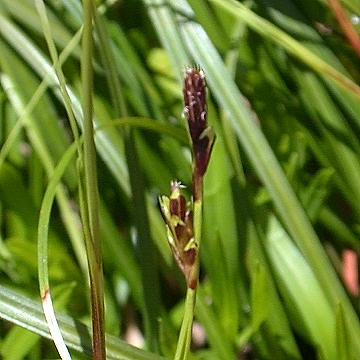

Carex pedunculata - (image 1 of 6)
Taxonomy
Family: Cyperaceae
Habitat
Woodlands, particularly dry calcareous woods.
Associates
Distribution
Newfoundland west to Saskatchewan and SD, south to NC, AL and IA; frequent in the Great Lakes Region.
Morphology
Tufted, evergreen sedge, to 12 cm from short rhizomes; leaves mostly basal, stiff, to 30 cm long and 3 mm wide; sheaths purplish and bearing leaf blades. Spikes 4-5, 6-15 mm long; terminal spike staminate, sometimes with a few perigynia at the base; perigynia inflated, glabrous or slightly hairy, 4-4.5 mm long, the beak short and hooked; scales equaling or exceeding the perigynia, sides purple-brown, the center green and extending to an awn; achene trigonous.
Notes
Fruiting April to June
Wetland indicator: FAC
The perigynia bear an elaiosome at the base and are dispersed by ants (e.g. Aphaenogaster rudis). This was the first sedge in North America to be identified as a myrmecochore. Although the perigynia are shed early, with practice this species can be identified fairly confidently by the small tufts of evergreen leaves with cuspidate tips.
References
Curtis, L. 2006. Woodland Carex of the upper Midwest. Lake Villa, IL.
Gleason, Henry A. and A. Cronquist. 1991. Manual of Vascular Plants of
Northeastern United States and Adjacent Canada. Second Ed.
The New York Botanical Garden. Bronx, NY
Handel, Steven N. 1976. Dispersal Ecology of Carex pedunculata (Cyperaceae),
a New North American Myrmecochore.
American Journal of Botany, 63(8).
Swink, F. and G. Wilhelm. 1994. Plants of the Chicago Region.
Indiana Academy of Science. The Morton Arboretum. Lisle, Illinois.
|
© Michael Hough 2010 |